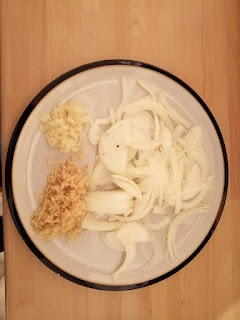Beans, beans, the musical fruit. You've got to love your legumes. I've already done a few dishes containing beans and they really make a hearty dish all the more hearty. Of course, the undigestible complex carbohydrates they contain make a good food source for the bugs that live up your arse. And when they get fed, they celebrate by making methane and hydrogen. This is when the brass section gets cued into the performance and Le Petomaine makes an appearance.
So we have beans, peas and other pulses which make up a substantial source of protein for a huge part of the human population. The soya bean alone feeds vast swathes of the far eastern portion of the Asian continent, especially as bean curd, not to mention being a fundamental component of the cuisine of literally billions of people when fermented in various ways in the shape of soy sauce, black bean sauce or the myriad of coloured pastes in Chinese, Japanese and Korean dishes (yellow bean, red bean, black bean, gochujang etc). Further west, the legume of choice becomes the lentil. Given the number of devout Hindus in India, they consume huge amounts of lentils as a good source of protein. So much so that there are numerous forms of these titchy little pea things available. This page lists 12 types of the flatulent little fuckers.
Lentils were something of a joke when I was growing up, being the relatively affluent, privileged Western European with a diet containing meat that I am (certainly compared to your average Indian of the time, anyway). Lentils were the staple of weirdo vegetarians, we didn't eat that sort of thing. Well, apart from when money got a bit tight (as I say, relatively affluent, compared to truly impoverished people in the Sub-Continent), so there was a trip to the butchers to get a batch of bacon bones and a thick, hearty broth was made up with these, with scraps of meat on them, and yellow split peas, a form of lentil. It lasted for days, and it was my first actual exposure to the lentil.
Anyway, back to the recipe in hand. Dhansak, though a popular dish in UK curry houses, is actually a recipe brought to India by Parsis, an ethnic group originating in Persia. It's a very tasty take on a curry, with the lentils bulking up the whole thing, and giving a nutty taste and adding richness to a sweet and tangy flavoured sauce.
TIMING
Preparation: 20 minutes
Cooking: 20-30 minutes on the pre-ccoking hob, 5 hours in the slow cooker
(You could do this on the hob or in the oven, though cooking time would be shorter. See notes for more details)
INGREDIENTS
2 tbsp vegetable oil
1 large onion, sliced
4 cloves of garlic
chunk of fresh ginger, finely chopped (aboout the size of a thumb, about 3cm by 2cm)
1 tsp ground cumin
1 tsp ground coriander
½ tsp ground turmeric
½ tsp ground fenugreek seeds
½ tsp ground black pepper
piece of cinnamon bark (about 5cm)
1 bayleaf
1 star anise
3 green cardamom pods
3 whole cloves
A pinch of onion seeds
1.2 tsp salt
1-2 fresh green chillies, finely chopped (depends on heat)
200g diced lamb
150g tomatoes blended up, or peeled and chopped
Juice of half a lemon
2 tsp sugar
Half a butternut squash, peeled, cored and chopped into bite-sized chunks
75g dried chana dhal
RECIPE
Heat the oil in a heavy-based pan and add the onions, garlic and ginger.
Fry for about 5 minutes until the onions are soft, then add the spices and salt.
Continue stirring so it doesn't stick, adding a splash of water if it looks a bit dry.
Add the lamb and keep sauteing for about 5 more minutes, until the meat is browned.
Throw in the tomatoes, lemon juice, sugar, chana dhal and squash and stir wel.
Add 300ml water and bring to a gentle boil.
Pour the lot into your slow cooker, set it to medium, cover, and leave it for a few hours (at least 5 in a slow cooker, but see notes for alernative methods).
Allow the amazing aroma permeate your house, then serve with pilau rice,and naan bread or add a vegetable side dish if you're hungry.
NOTES
This is made with lamb, but I've also made it with chicken (bone-in thighs, skinless), though you could cook it for less time, or would also work with beef.
I used chana dhal, which is a fairly large lentil, almost as big as a chickpea, which holds its shape well, becoming tender but still quite firm after a long, slow cook. Regular red lentils have a tendency to disintegrate, which would also work, though will add a different texture to the dish
Other vegetables would work in this, but sturdy root vegetables stand up to long cooking. Mushrooms would also work, espeicaly if you did this with beef instead of lamb. Pumpkins, like squashes, work so well in a curry, however.
You could make this on the hob or even in a casserole dish in the oven. You could probably get away with a couple of hours on the stove, and maybe three in the oven. The joy of the slow cooker is the fact that the dish is you can stick it on, forget about it until you're ready to eat it
This blog entry sees me return to a subject I've touched on before in this blog, the act of farting. Farting is, and always will be, hilariously funny. Don't take my word for it, ask my son (9 years old at the time of writing). He'll agree.
Why were lentils regarded as something of a joke food when I was growing up? This is part of the reason why:
















